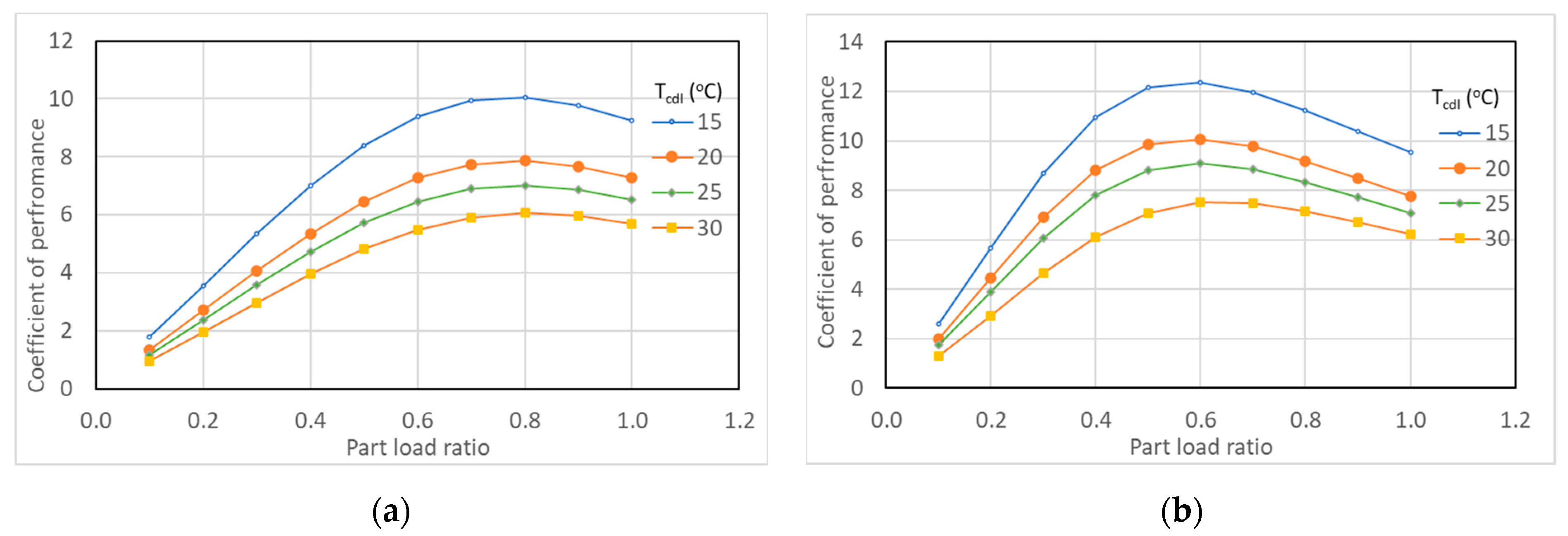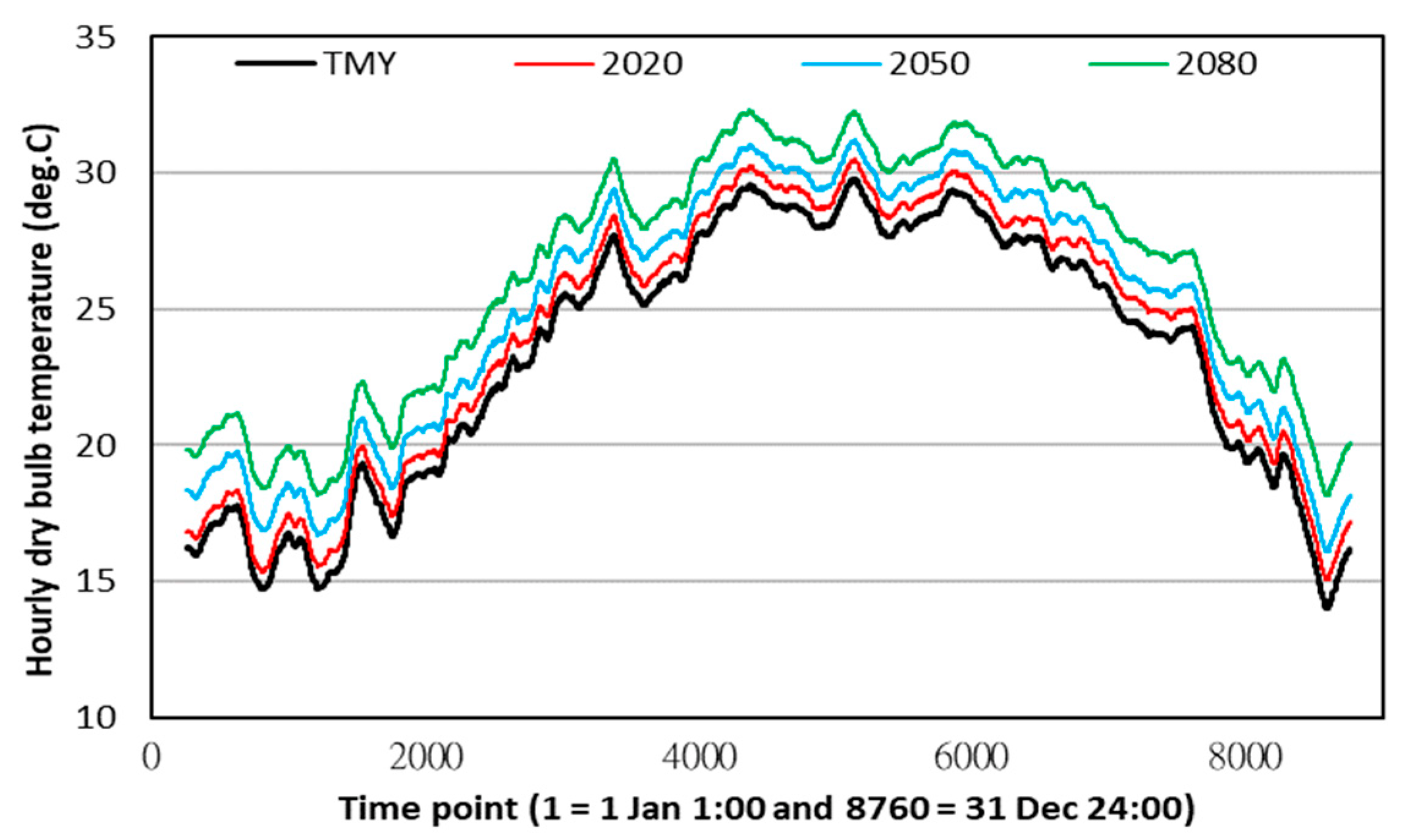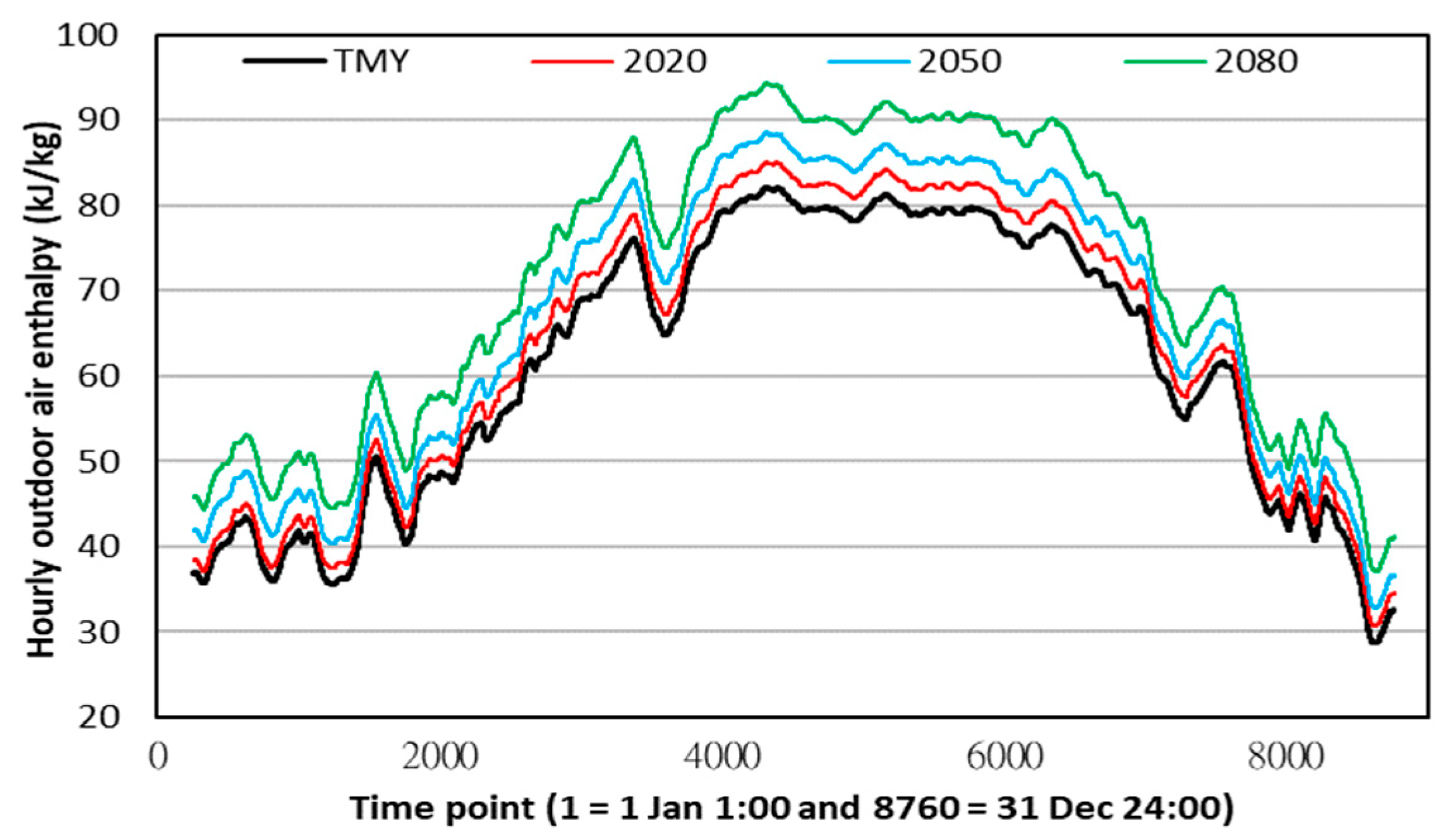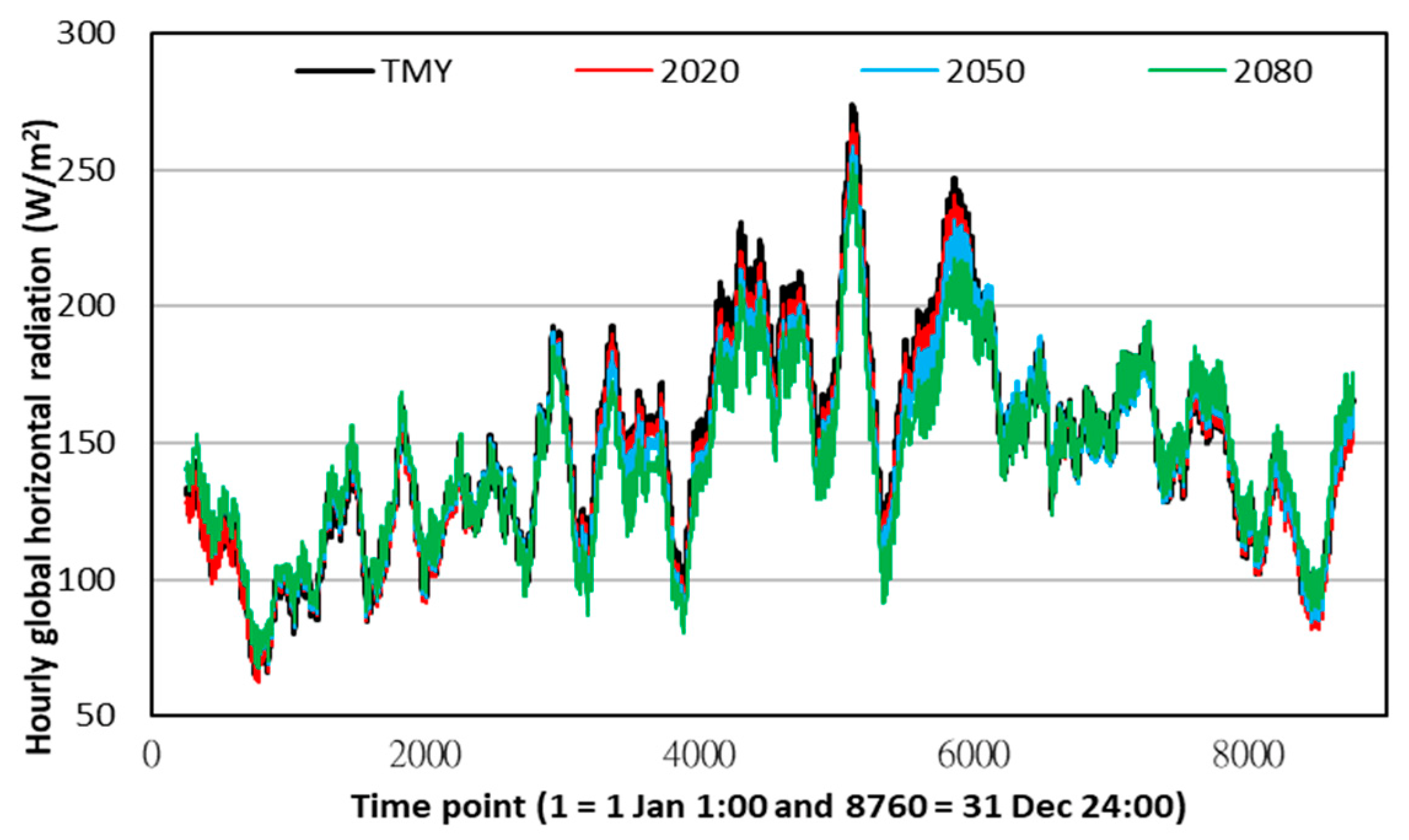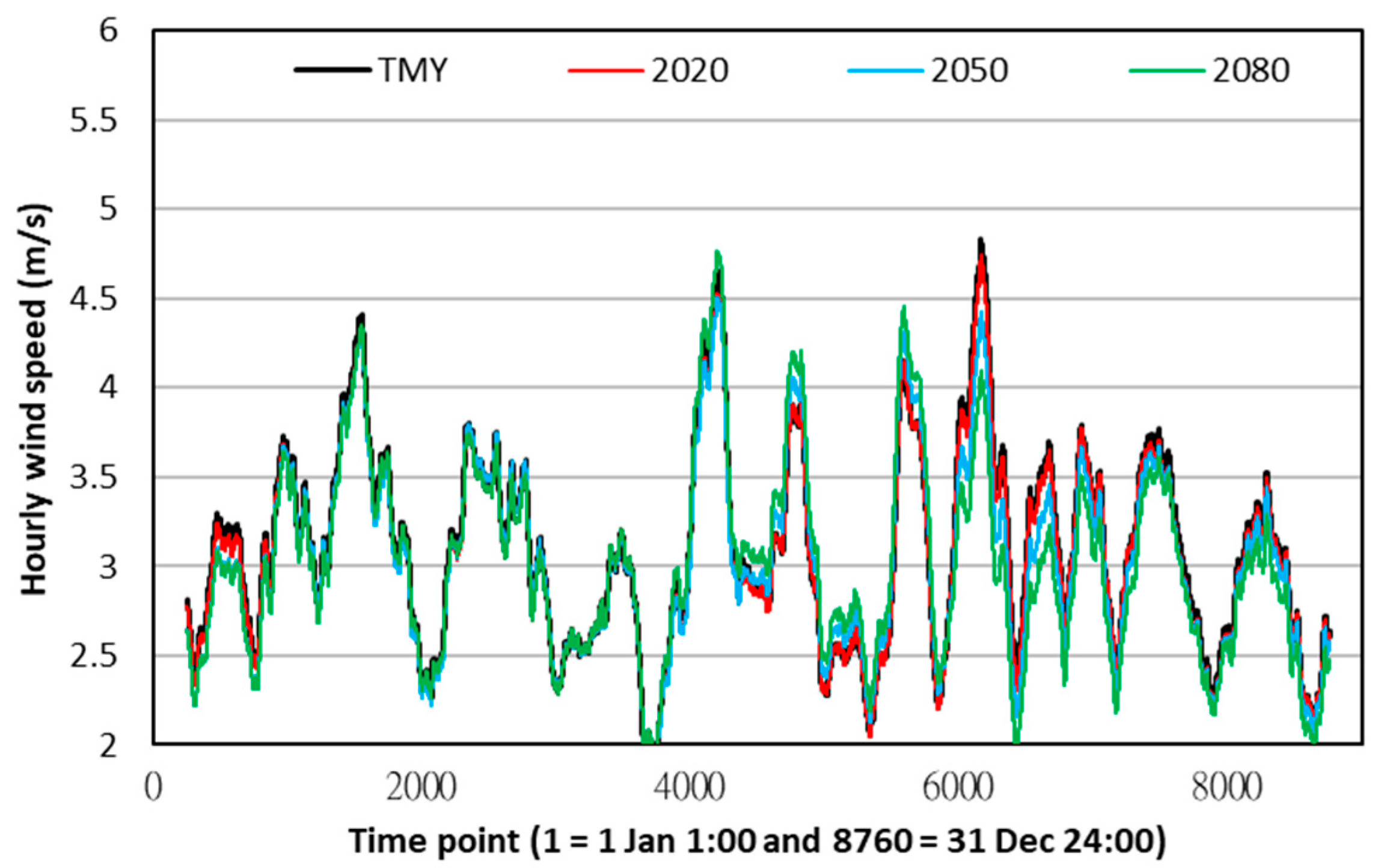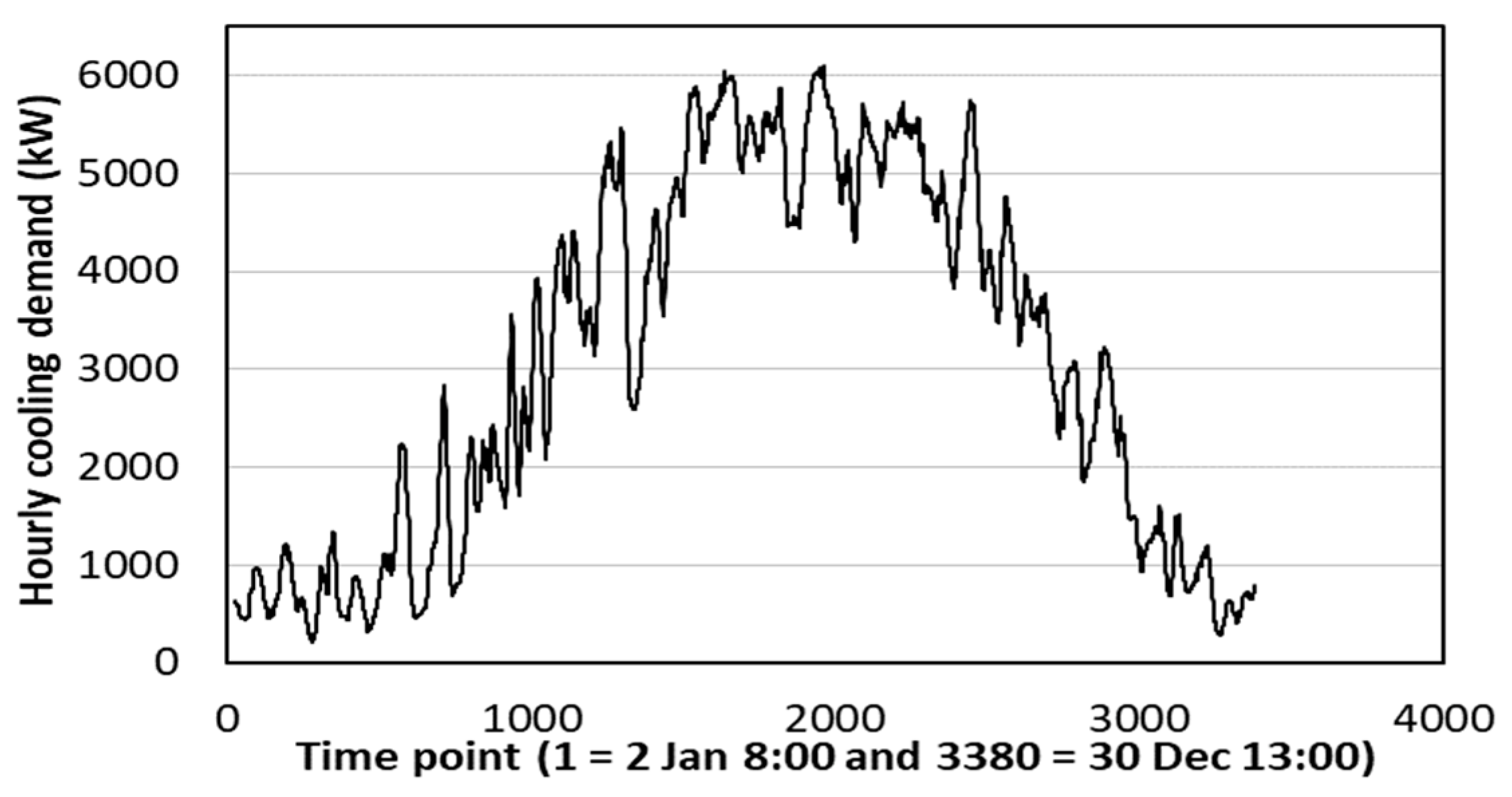4.1. Cooling Demand Profiles at Various Combinations of WWR and Weather Data
Simulation results from EnergyPlus were processed with changes of WWRs of 0.4, 0.5, 0.6, 0.7 and 0.8 and four sets of weather data in TMY, 2020, 2050 and 2080.
Figure 7 shows the hourly cooling-demand profile in the base case with a WWR of 0.4 and TMY. There are 3380 time points based on operating hours of the HVAC system in the year. The lowest cooling demand occurs in January and the peak cooling demand occurs in July. The cooling demand is non-zero in winter months with outdoor temperatures below 20 °C because there are solar heat gains from windows and internal loads from occupants and equipment. The seasonal variation of the profile generally follows the profiles of the outdoor temperature and outdoor air enthalpy given in
Figure 3 and
Figure 4.
Figure 8 gives the percentage changes of hourly cooling demands in January and July from the base case with higher WWRs from 0.5 to 0.8. For the bottom tier of cooling demands in January, the higher WWRs result in higher percentage increases of the cooling demand. For the top pier of cooling demands in July, the percentage increase is up to 12.8% in the hourly cooling demands with higher fluctuation in successive hours.
Figure 9 shows the increase of hourly cooling demands with a WWR of 0.4 in 2020, 2050 and 2080 in relation to the TMY. Light cooling demands in winter months can increase by 17.9–102.8% with time points 1–544 and 2820–3380. On the other hand, the upper cooling demands increase slightly by 9.0–21.6% in summer months with time points 1106–2258. When considering the extension of cooling demands in the future climate, the chiller system capacity should not be oversized by more than one-fourth of the peak cooling demand to avoid operating chillers at low PLRs under light cooling demands.
Overall, simulation results of cooling demand profiles show various daily variations under five WWRs and four weather conditions. The data sets are comprehensive to train and test the time series cooling-demand model for further analysis of carbon reduction by free cooling and a full variable speed chiller system.
4.2. Time Series Cooling-Demand Model and Its Validation
Pearson correlation coefficients are presented in
Table 5 for input variables of WWR,
to,
ho, GHR and v described in
Section 3.1. The variables
to and
ho are found to be highly correlated with a correlation coefficient of 0.95224. Based on the warm-humid climate in Hong Kong with a minor variation in relative humidity, the correlation between
to and
ho follows generally the psychrometric properties of air. Their selection in the final model is based on the variance inflation factors (VIFs) and the change of R
2 when dropping out either
to or
ho.
Table 6 shows the statistical results of a general regression model without one or two steps ahead. The model has an R
2 of 0.901, which indicates 90.1% of the change of cooling demand can be explained by the variation of input variables. Yet, the VIFs of above 10 are observed in
to and
ho, which confirms their high correlation in the model. Dropping out
to and
ho individually from the model gives an R
2 of 0.891 and 0.881, respectively. The preference of including
ho and excluding
to in the model is also supported by a high standardized coefficient of 0.533 for
ho compared with 0.395 for
to. The VIFs vary between 1.000–1.182, which are well below 5 when excluding
to from the five input variables. The time series regression model will be developed based on the input variables of WWR,
ho, GHR and v. Most building management systems monitor only the outdoor temperature and no other properties of outdoor air. While
to can be measured and logged directly, the higher priority of
ho ascertains a need of monitoring the outdoor air enthalpy by two climatic variables (e.g.,
to and relative humidity) to predict the change of cooling demands. Indeed, relative humidity itself has a very low correlation with the cooling demand. It is more preferable to use
ho, which captures the heat gained from the water vapor of outdoor air compared with using
to solely. When free cooling is applied, the outdoor air enthalpy is highly correlated with the indoor air enthalpy, which has a stronger impact on the thermal acceptability than other thermal parameters [
36].
Table 7 and
Table 8 show statistical results of the time series models with only one step ahead (i.e., the t − 1 term) and two steps ahead (i.e., the t − 1 and t − 2 terms). The R
2 can be improved from 0.891 to 0.914 with one step ahead and further, to 0.919 with two steps ahead. The
ho and GHR are the most significant variables to model the cooling demand because they are important variables to calculate the ventilation load and solar heat gain from windows. Based on standardized coefficients in
Table 8,
ho,t−1 has a heavier weighting than
ho,t and
ho,t−2. GHR
t−2 has the highest weighting compared with GHR
t and GHR
t−1. This corroborates the delayed effect of converting the solar heat gain through the building envelope into the cooling demand. On the other hand, v
t has the highest weighting, but the inclusion of v
t−1 and v
t−1 has no significant effect. Overall, the time series model has improved accuracy with two steps ahead for
ho and GHR. This model development shows the advancement of including previous time steps of explanatory variables.
Equation (10) is established to model the cooling demand (
CDt) at time
t with an R
2 of 0.919 based on the training set. Its validity was further examined by three testing sets under climate conditions in 2020, 2050 and 2080.
Table 9 shows that the values of R
2 in the testing sets are even higher than 0.919 in the training set. This ascertains the model accuracy under climate change conditions and supports the use of predicted hourly cooling demands to evaluate carbon reduction by the low carbon chiller system using full variable speed control and free cooling.
This simplified model is a viable tool when a complete set of weather data in the epw format is not available to perform simulation in EnergyPlus. The sensitivity of cooling demands at different WWRs and climatic variables can be assessed directly without changing the building modules in EnergyPlus. Furthermore, the hourly cooling demand profile can be easily generated to evaluate alternative low carbon technologies for HVAC systems that are not yet covered or developed in EnergyPlus system modules.
4.3. Electricity Uses and Carbon Emissions of Chiller System with Conventional and Low Carbon Design
Having found the cooling demand profiles under future climate conditions, the electricity use and carbon emissions are predicted for the chiller system under constant speed control and full variable speed control with free cooling. Other electricity use components for the airside system, lighting system and electrical appliances are skipped in this analysis because they are considered the same at different cooling demand profiles.
Table 10 summarizes the annual cooling demands in kWh under all combinations of WWRs and climate conditions. The annual cooling demand in 2080 can increase by 30.28–32.70% from the base case of TMY. This suggests that improving the energy performance of HVAC systems should be strengthened to reduce electricity use to a large extent and, hence, to attain a downward trend in carbon emissions.
Table 11 shows the annual electricity uses in kWh of the chiller system at different WWRs and climate conditions. The system involves the conventional design with proper staging of constant speed chillers to match different cooling demands. The percentage increase of the annual electricity use follows roughly with the annual cooling demand. To temper the increasing electricity use under future climate conditions, it is important to increase the COP of the chillers, enhance the energy efficiency of the pumps and cooling tower fans and to use free cooling to compensate for the cooling demand as far as possible.
The annual cooling demand data in
Table 10 form the base cases without applying free cooling (FC).
Table 12 shows the percentage change of annual cooling demands after applying FC from the base cases. Under the TMY, FC enables the annual cooling demand to drop by 4.96–5.76%, depending on the WWRs. In addition, the chiller system can be switched off for 22.99–24.11% of the total operating hours. Under future climate conditions, the potential of applying FC is tempered significantly. In 2080, the percentage reduction of annual cooling demand is limited to 3.21–3.52% in relation to 4.96–5.76% in the TMY. The percentage of time to switch off the chiller system shrinks to 9.05–9.91% in relation to 22.99–24.11% in the TMY.
Table 13 shows how the annual electricity use drops when applying the full variable speed chiller and system in relation to the conventional system. Compared with results in
Table 11, the full variable speed chiller system can reduce the annual electricity use by 16.76–17.13% in the TMY and further, by 20.8–22.55% in 2080. The percentage electricity savings are associated with higher equipment efficiency at part-load operation. This suggests that improving the energy performance of the chiller system helps suppress the rising electricity use under future climate conditions. Yet, the percentage drop needs to complement with other low to zero carbon technologies in achieving a proposed energy reduction target of 30–40% in commercial buildings for carbon neutrality in Hong Kong’s climate action plan 2050 [
33].
Table 14 shows how free cooling can further decrease the annual electricity use with the full variable speed chiller system. Comparing results of percentage changes in
Table 13 with
Table 14, free cooling brings additional annual electricity savings of 3.66–4.03% in the TMY and 2.38–2.55% in 2080. The shrinkage of electricity savings under future climate conditions is associated with the tempering of reduction in the annual cooling demands as shown in
Table 12. These percentage energy savings are much lower than 27% found in a study on the cooling performance of an existing commercial building in Canada [
37]. Considering that the percentage changes of the annual electricity use can contribute partly to a proposed energy saving target of 30–40% in commercial buildings, low to zero carbon technologies should be strengthened to the building envelope, other HVAC components, a lighting system, lift and escalator system and photovoltaic system [
38,
39]. This calls for future research work on simulating various energy saving scenarios for different engineering systems to develop a stereotype of high-rise office buildings in Hong Kong to meet carbon neutrality.
The simplified cooling demand model considers only the basic architectural variable, i.e., the WWR. There are other variables influencing the thermal performance of building envelopes, such as the thermal resistance of envelope materials, the water vapor permeability coefficient, the sealing property, etc. These architectural variables will vary with the building age and the technological advancement of envelope components will interact with the cooling demand profile in the long run. It is worth introducing more architectural variables to enhance the robustness of the cooling demand prediction.
Table 15 gives a summary on the reductions of carbon emissions in kgCO
2-e by using free cooling and full variable speed chiller system at different WWRs and climate conditions. The studied building with a WWR of 0.4 under the TMY has a total electricity consumption is 9,671,391.667 kWh, an energy use intensity of 186.56 kWh/m
2 and carbon emissions of 5,802,835 kgCO
2-e. The carbon reduction due to the low carbon chiller system operation accounts for 4.84–5.07% in 2020, 4.92–5.32% in 2050 and 5.25–5.90% in 2080. This indicates a need for exploring energy saving opportunities for other building systems, so that the aggregate carbon reduction meets a proposed target of 50% before 2035 in Hong Kong’s climate action plan 2050 [
28]. Renewable applications should be widened in high-rise buildings to directly reduce carbon emissions.
This study investigates carbon reduction opportunities mainly from the perspective of building energy efficiency. In fact, the reduction of carbon emission factors from the power supply side is a direct means to suppress carbon emissions for an increasing electricity demand trend under climate change. Widening gas-fired power plants and phasing out coal-fired power plants are the roadmap for power companies in Hong Kong to further reduce the carbon emission factor from the current level of 0.6 kgCO2-e per kWh.
